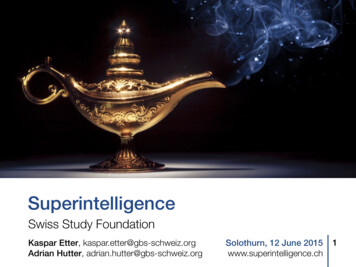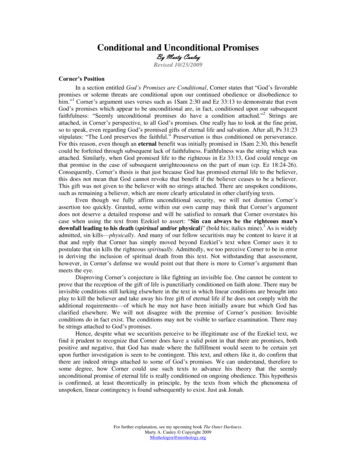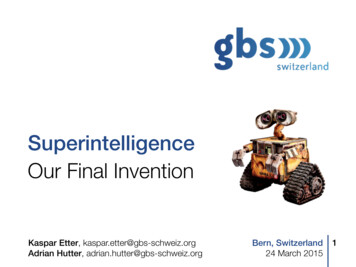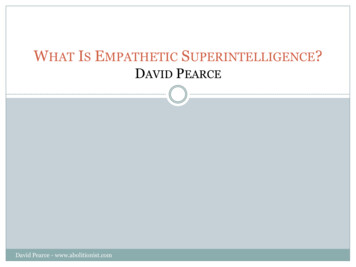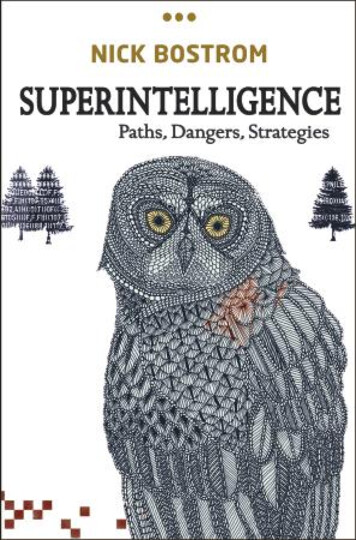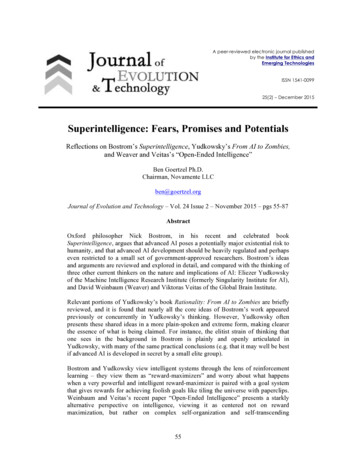
Transcription
A peer-reviewed electronic journal publishedby the Institute for Ethics andEmerging TechnologiesISSN 1541-009925(2) – December 2015Superintelligence: Fears, Promises and PotentialsReflections on Bostrom’s Superintelligence, Yudkowsky’s From AI to Zombies,and Weaver and Veitas’s “Open-Ended Intelligence”Ben Goertzel Ph.D.Chairman, Novamente LLCben@goertzel.orgJournal of Evolution and Technology – Vol. 24 Issue 2 – November 2015 – pgs 55-87AbstractOxford philosopher Nick Bostrom, in his recent and celebrated bookSuperintelligence, argues that advanced AI poses a potentially major existential risk tohumanity, and that advanced AI development should be heavily regulated and perhapseven restricted to a small set of government-approved researchers. Bostrom’s ideasand arguments are reviewed and explored in detail, and compared with the thinking ofthree other current thinkers on the nature and implications of AI: Eliezer Yudkowskyof the Machine Intelligence Research Institute (formerly Singularity Institute for AI),and David Weinbaum (Weaver) and Viktoras Veitas of the Global Brain Institute.Relevant portions of Yudkowsky’s book Rationality: From AI to Zombies are brieflyreviewed, and it is found that nearly all the core ideas of Bostrom’s work appearedpreviously or concurrently in Yudkowsky’s thinking. However, Yudkowsky oftenpresents these shared ideas in a more plain-spoken and extreme form, making clearerthe essence of what is being claimed. For instance, the elitist strain of thinking thatone sees in the background in Bostrom is plainly and openly articulated inYudkowsky, with many of the same practical conclusions (e.g. that it may well be bestif advanced AI is developed in secret by a small elite group).Bostrom and Yudkowsky view intelligent systems through the lens of reinforcementlearning – they view them as “reward-maximizers” and worry about what happenswhen a very powerful and intelligent reward-maximizer is paired with a goal systemthat gives rewards for achieving foolish goals like tiling the universe with paperclips.Weinbaum and Veitas’s recent paper “Open-Ended Intelligence” presents a starklyalternative perspective on intelligence, viewing it as centered not on rewardmaximization, but rather on complex self-organization and self-transcending55
development that occurs in close coupling with a complex environment that is alsoongoingly self-organizing, in only partially knowable ways.It is concluded that Bostrom and Yudkowsky’s arguments for existential risk havesome logical foundation, but are often presented in an exaggerated way. For instance,formal arguments whose implication is that the “worst case scenarios” for advancedAI development are extremely dire, are often informally discussed as if theydemonstrated the likelihood, rather than just the possibility, of highly negativeoutcomes. And potential dangers of reward-maximizing AI are taken as problems withAI in general, rather than just as problems of the reward-maximization paradigm as anapproach to building superintelligence. If one views past, current, and futureintelligence as “open-ended,” in the vernacular of Weaver and Veitas, the potentialdangers no longer appear to loom so large, and one sees a future that is wide-open,complex and uncertain, just as it has always been.1. IntroductionThese times of obvious exponential technological acceleration are especially exciting for those of us whowork on building thinking machines – what I call “Artificial General Intelligence” and others havesometimes called “Strong AI.” In fact, the present scene confronts us AGI researchers with an intriguingsituation. On the one hand, we are in a world newly filled with widespread optimism about the viability ofachieving advanced AGI. On the other hand, we concurrently confront a minor epidemic of pessimism –at least in the media, and among a handful of high-profile commentators – about the desirability ofachieving this goal.To put it differently: In the last couple years, all of a sudden, when I tell someone I’m working onbuilding AGIs with general capability at the human level and beyond, the first reaction is no longerinevitably “You’re nuts, that’s not possible now – maybe in ten thousand years,” but is just as likely to be“Wait, didn’t Google already do that last year?” And the second reaction is fairly likely to be, “But isn’tStephen Hawking worried that, if anyone does build a truly smart machine, it’s going to kill everybody?”The current state of scientific and technological development is still pretty far from human-level AGI. Butwe all know progress in science isn’t generally linear, and recent practical successes of “narrow,”application-specific AI programs seem to have – more so than prior AI successes – dramatically increasedthe world’s general impression that we could possibly be nearing a period of rapid increase in the generalintelligence of our AI systems.And it is this apparent progress that has led science and technology luminaries like Elon Musk (Kumpara2014), Stephen Hawking (Cellan-Jones 2014) and Bill Gates (Holley 2015) to publicly raise an alarmregarding the potential that, one day not necessarily that far off, superhuman AIs might emanate fromsome research lab and literally annihilate the human race. As Peter Norvig of Google has noted (personalcommunication), quite suddenly we’ve gone from outrage at the perceived failure of AI research, tooutrage at the perceived possible success of AGI research!One of the most influential recent voices to express worry about the possible consequences of AGI is thatof Oxford philosopher Nick Bostrom, whose recent book Superintelligence: Paths, Dangers, Strategies(Bostrom 2014) has received plaudits far and wide. In fact, it seems that Bostrom’s book may have beenpart of what raised the hackles of Gates, Musk, and Hawking regarding the potential near-to-medium termrisks of advanced AI R&D.56
Most of the themes of Superintelligence were already familiar to me before opening the book, due tohaving read so many of Nick Bostrom’s papers in the past – along with a few face-to-face conversationswith Nick, e.g. when we co-organized the AGI-Impacts conference at Oxford in 2012. However, none ofBostrom’s previous writings have assembled his ideas on these themes nearly so systematically andcohesively. Clearly the book was the product of a long and careful effort.In this moderately lengthy review-and-discussion article I summarize my reaction to Bostrom’s book andideas. A truly thorough analysis and criticism of Bostrom’s themes would require a response longer thanthe book itself; here I restrict myself to what I see as the main points of Superintelligence, thosepertaining directly to the perceived “existential risk” of advanced AI. This is the aspect of Bostrom’sbook that has attracted the most attention in the media and the intellectual sphere.2. Scratch the surface of Bostrom, find YudkowskyMy first reaction, as I paged with curiosity through Bostrom’s gloomy, erudite tome, was to be struck bythe remarkable similarity between the arguments, and the general attitude presented, and the perspectiveon the future of AI put forth by Eliezer Yudkowsky over the last 15 years or so. Yudkowsky has not (yet)written any single document as thorough and carefully-wrought as Superintelligence. But in mailing listand blog posts and online essays over the years, he has articulated a perspective very close to Bostrom’s,and in many ways possessing more depth and nuance.The situation seems broadly similar to the argument for the plausibility of a Technological Singularitythat celebrated philosopher David Chalmers put forth in his article “The Singularity: A PhilosophicalAnalysis”, published in the Journal of Consciousness Studies in 2010 (Chalmers 2010). The corearguments presented by Chalmers were very familiar to knowledgeable readers from prior writings byVernor Vinge, Ray Kurzweil and others. But these other authors had presented their arguments morecasually and informally. Chalmers gave the argument for a Singularity a full-on analytic-philosophytreatment, which yielded some value. For instance, he made very clear that the vagueness of the conceptof “intelligence” is no objection to the Vingean/Kurzweilian arguments for a Singularity. It’s OK if“intelligence” is a confusingly weighted and interrelated grab-bag of different capabilities, so long assome of the key capabilities among this set have the right properties regarding being ongoingly pumpablevia improvements in technology.Similarly to Chalmers’ excellent essay, there is not really much that’s new conceptually in Bostrom’sbook. But what others (especially, but not only, Yudkowsky) previously put forward more informally orerratically, regarding the potential for existential risk from superintelligence, Bostrom has now articulatedwith the detail and intellectual force of a top-notch analytic philosopher. It helps that he is a very goodwriter, mixing academic rigor with occasional color and humor in a classic European style.Less of an academic than Bostrom (he’s never been to college, let alone acquired a Ph.D.) and more of amaverick, Yudkowsky has accumulated a substantial community of enthusiasts to help him develop andextend his ideas. Yudkowsky’s Machine Intelligence Research Institute (previously Singularity Institutefor AI) is edgier and less “establishment” than Bostrom’s Oxford-based Future of Humanity Institute, butthe two groups have strongly overlapping attitudes and mandates. Recently a large collection ofYudkowsky’s blog posts have been gathered in a book titled Rationality: From AI to Zombies(Yudkowsky 2015). This book covers a variety of topics besides superintelligence, yet the majority ofYudkowsky’s points tie into the superintelligence theme via one moderately direct route or another. Forinstance, Yudkowsky’s long-standing preoccupation with “the art of rationality” was originally motivatedsubstantially by a desire to make himself and others rational enough to think effectively about the path tofriendly superintelligence. While his scope of interests is fairly wide-ranging (though with some specific,and in some cases telling, limits that will be noted below), the creation of human-friendly57
superintelligence (or in his coinage, “Friendly AI”) has been Yudkowsky’s focus for the whole of hiscareer and adult life.Compared to Yudkowsky, Bostrom’s tone is far more sober and academic. Yudkowsky – to summarize abit too glibly – generally writes for young enthusiasts who want to feel like they’re members of anexclusive club of super-brights who understand what’s really going on in the world. Bostrom presentsclosely related ideas in a fashion tailored for the sober, buttoned-down grown-up world, spelling outcomplex arguments regarding themes that would normally reek of SF in such an impressively clear,reasoned and compelling way that the reader can’t help but take them seriously.In the remainder of this article, I will give some of my main reactions to Bostrom’s and Yudkowsky’sbooks; and I will also seek to present their ideas in the context of a broader perspective onsuperintelligence, and its promises and risks.While my comments on Bostrom’s and Yudkowsky’s writings will sometimes be critical, I want to stressthat I consider both Bostrom and Yudkowsky valuable commentators on the future of AI and humanity.More than that, I often find their perspectives delightful to encounter, even when I disagree with them!The future is hard to understand, and having a wide variety of smart, creative people thinking about itfrom various perspective, seems almost sure to be a Good Thing at the present stage.3. Some important things Bostrom and Yudkowsky get rightOn some key points, I feel Bostrom and Yudkowsky get it just right, whereas the mainstream of the AIresearch community and the tech media doesn’t quite. They fully get the dynamics of exponentialadvance, and the ever present potential for sudden dramatic breakthroughs in cutting-edge science.For instance, Microsoft founder Paul Allen argues that “the Singularity is far” (Allen 2011), and even intoday’s optimistic climate, I would bet that a substantial plurality or even a majority of AI professors atleading universities agree with him. Arguments with such folks tend to end up writhing around in amorass of confusing details, with nobody convinced to give up their initial position. Given the currentstate of AI technology, we really can’t know exactly when “true AGI” or “human level AI” is going toemerge – and we also can’t know that much about what the first true AGI systems are going to be like, sowe can’t say anything especially confident about the risks these systems may actually pose.On the other hand, Singularity pessimists like Allen do seem to miss some of the points Bostrom socarefully outlines. Progress in science is often not linear. Often progress proceeds step by step for a while– and then some breakthrough happens, disrupting the state of the art and reorienting much of the field’sefforts toward exploring and leveraging the breakthrough. Kurzweil likes to point out that exponentialprogress curves are made of cascades of “S” curves, a new one starting after the previous one.From Bostrom’s point of view, the Singularity optimists don’t need to be fully right in order forsuperintelligence to be a major ethical concern. As he sees it, if human-level AGI is created it’s verylikely to lead fairly soon after to superintelligence; and if superintelligence is created without extremelyparticular conditions being met, then it’s very likely to lead to terrible outcomes like the extermination ofall humans. Therefore if there’s even a 1 per cent chance that Singularity optimists are correct about thenear advent of human-level AGI, there’s a major risk worthy paying careful attention to.Bostrom cites a number of surveys of AI experts regarding the likely time-horizon of the advent ofadvanced AGI, including a survey my father (Ted Goertzel), Seth Baum, and I did at the AGI-09conference in Washington DC (Baum et al. 2010). Overall a majority of these experts expect human-levelAGI this century, with a mean expectation around the middle of the century. My own predictions are58
more on the optimistic side (one to two decades rather than three to four) but in the scheme of things thisis a pretty minor difference.Bostrom notes that many of the experts surveyed expect a significant gap between the achievement ofhuman-level AGI, and the emergence of radically superhuman AGI. He expects the gap to be smaller –more likely years than decades. Here also I tend to agree with him. Ray Kurzweil predicts the advance ofhuman-level AI in 2029, and a general technological Singularity in 2045. On this I side with NickBostrom – I tend to think the gap between a human-level thinking machine and a world-transformingSingularity type event will be significantly less than 16 years.Another point Bostrom hits home very well is the qualitative difference one can expect between theeventual superhuman AGIs we are likely to see emerge, and very smart human beings. As he puts it,using an example that also occurs in Yudkowsky’s book and that I’ve seen in some of Yudkowsky’sconference presentations over the years: It’s not like the difference between Einstein and the village idiot,but more like the difference between the ultimately-fairly-similar minds of Einstein and the village idiot,and a mouse or a bacterium. Yes.I tend to agree with Hugo de Garis (2005; Goertzel 2011) that anyone who thinks the end-game of AGI isgoing to be a mere modest improvement on human intelligence doesn’t get the potential for intelligenceinherent in the universe’s available mass-energy.1 The variety of intelligence that happens to haveevolved in human brains appears to be nowhere near the maximally intelligent possible organization ofmass-energy that the known laws of physics allow (not to mention physics as it will be understood bysuperintelligence ).4. Staring into the SingularityYudkowsky understood the disruptive, frightening, exciting majesty of the Singularity pretty clearly wayback in 1996 when he wrote the first version of his classic online essay “Staring into the Singularity”(parts of which he now repudiates; Yudkowsky 2001). “Staring” starts off with a bang:The short version:If computing speeds double every two years,what happens when computer-based AIs are doing the research?Computing speed doubles every two years.Computing speed doubles every two years of work.Computing speed doubles every two subjective years of work.Two years after Artificial Intelligences reach human equivalence, their speeddoubles. One year later, their speed doubles again.Six months – three months – 1.5 months . Singularity.Plug in the numbers for current computing speeds, the current doubling time, and anestimate for the raw processing power of the human brain, and the numbers match in:2021.1Though I should perhaps add that I don’t agree with de Garis’s various political prognostications.59
But personally, I’d like to do it sooner.1: The End of HistoryIt began three and a half billion years ago in a pool of muck, when a molecule made acopy of itself and so became the ultimate ancestor of all earthly life.It began four million years ago, when brain volumes began climbing rapidly in thehominid line.Fifty thousand years ago with the rise of Homo sapiens sapiens.Ten thousand years ago with the invention of civilization.Five hundred years ago with the invention of the printing press.Fifty years ago with the invention of the computer.In less than thirty years, it will end.At some point in the near future, someone will come up with a method of increasingthe maximum intelligence on the planet – either coding a true ArtificialIntelligence or enhancing human intelligence. An enhanced human would be better atthinking up ways of enhancing humans; would have an “increased capacity forinvention”. What would this increased ability be directed at? Creating the nextgeneration of enhanced humans.And what would those doubly enhanced minds do? Research methods on triplyenhanced humans, or build AI minds operating at computer speeds. And an AI wouldbe able to reprogram itself, directly, to run faster – or smarter. And then our crystalball explodes, “life as we know it” is over, and everything we know goes out thewindow.“Here I had tried a straightforward extrapolation of technology, and found myselfprecipitated over an abyss. It’s a problem we face every time we consider the creationof intelligences greater than our own. When this happens, human history will havereached a kind of singularity – a place where extrapolation breaks down and newmodels must be applied – and the world will pass beyond our understanding.”– Vernor Vinge, True Names and Other Dangers, p. 47.Way back in the dark ages of the late 1990s and the early aughts, only a handful of wild-eyed visionarieswere touting this Vingean vision of the future.My impression from interacting with Yudkowsky at that stage (mostly online, occasionally in person) wasthat, back then, he seemed more excited than frightened about this sort of vision. I got the feeling that, atthat stage, he was hoping he could personally solve the problem of making a reliably human-friendly AGIreasonably soon, well before anyone else would make an unreliable or unfriendly AGI. When Yudkowskyled the founding of the Singularity Institute for AI in 2000, the vibe surrounding the organization seemedto be that Yudkowsky was hard at work trying to figure out the solution to the “Friendly AI problem,”and might just pop up with a breakthrough any day now. Due to his background as a child prodigy, andhis quick wit and obviously deep mind, he seemed to achieve an almost transhuman status in the minds ofmany SIAI enthusiasts of that era. I heard it said many times, in informal conversation, that Yudkowskymight be the only person alive smart enough to solve the Friendly AI problem.60
As time went on, though, it was clear that Yudkowsky became more and more impressed with thedifficulty of the problems involved with his quest for Friendly AI, both the issue of clearly articulatingwhat “friendly to humans or human values” really means, and the issue of making an AGI retain itshuman-friendly goals and values as it becomes massively, transhumanly superintelligent via meansbeyond human comprehension. He also became more and more impressed with the ability of the humanmind to fool itself and make basic cognitive errors, and started pondering the extent to which humanrationality was really up to the task of creating AIs that would grow into reliably friendly transhumanminds.This latter interest, in rationality, ended up occupying a lot of Yudkowsky’s time during the last decade –including a fairly large percentage of his blog posts, and his popular fan-fic series Harry Potter and theMethods of Rationality (Yudkowsky 2015). It also led him to carry out a major social-engineeringinitiative aimed at improving the level of rationality in the Singularitarian and tech communities, whichled to phenomena like “rationality boot camps” and the foundation of the Center for Applied Rationality(CFAR), a spin-off of SIAI/MIRI.These days, Yudkowsky is still much admired within CFAR/MIRI circles, and various of his ideas havespread far and wide. There has been a large amount of interaction between SIAI/CFAR/MIRI folks andthe more academic crowd at Bostrom’s Future of Humanity Institute; and via this connection along withmany other means, Yudkowsky’s ideas have wended their way toward the mainstream. With only mildoversimplification, one might say that Bostrom’s Superintelligence is a triumphal work synergizingBostrom’s communication and analytical ability and Yudkowsky’s creative ideas. Of course, thisoversimplification isn’t quite fair to Bostrom, who contributed a lot of detailed ideas to his book as well.But as for the Big Ideas in Superintelligence, it really seems that every one was articulated at some pointpreviously by Eliezer Yudkowsky.Today in 2015, lurking around the edges of the MIRI/FHI world, one doesn’t feel so much of a vibe thatYudkowsky is likely to singlehandedly emerge one day with a working Friendly AI, or even a detaileddesign for one. Rather, MIRI and FHI are seeking to grow a community of researchers who, together, willdevelop a research program giving concrete, rigorous form to Yudkowsky’s often rather abstract andslippery ideas.This process is already underway, in a sense – MIRI has hired a stream of excellent youngmathematicians who have started proving theorems inspired by Yudkowsky’s line of reasoning aboutFriendly AI. None of these theorems yet have any particular implications for the practical world. But asexploratory science/math, it’s certainly interesting stuff.5. Core ideas of Yudkowsky/Bostrom/MIRI/FHI–ismAs I’ve emphasized above, I agree with Bostrom and Yudkowsky on a number of (to me) fairly “basic”Singularitarian/transhumanist points, which nevertheless are not agreed on by the bulk of the scientificcommunity or the tech media at the present time. In his book, though, after establishing these basic points,Bostrom goes in a number of directions that I don’t wholly agree with. On essentially all of these pointshe concurs with Yudkowsky’s previously expressed views.The core tenets of the Yudkowsky/Bostrom/MIRI/FHI perspective, to summarize a bit crudely, goroughly like:61
1. Superintelligence is very likely possible, according to known physics.22. A very likely path to superintelligence is the creation of machines that can improvethemselves and increase their own intelligence, e.g. self-modifying software programs.33. In most cases, the future trajectory of a self-improving, superhuman intelligence will be veryhard for human beings to predict.44. If one creates a human-level AGI with certain human-friendly goals, and allows it to selfmodify freely, the odds are high that it will eventually self-modify into a condition where itno longer pursues the same goals it started out with.55. Most likely, a self-modifying superintelligence will end up pursuing goals that have littleconsonance with human values.6. Quite likely this would result in the end of the human race, as a superintelligence withoutmuch consonance with human values would probably have no more reason to care abouthumans than we humans do to care about the ants in the dirt under a construction site wherewe want to erect a building.6I tend to agree with points 1–4, partly with point 5, and not so much with point 6. In the overall spectrumof human attitudes, this places me very close to Bostrom and Yudkowsky – since, of course, most currenthumans consider point 1 highly questionable; and would consider points 2–5, if they ever thought aboutthem, as strange and dubious science-fiction speculations. On the other hand, our point of disagreement,6, is a fairly significant one, at least from a human perspective, since it pertains to the probability ofannihilation of the human race.One of the stronger points of Bostrom’s treatment is the way he clearly distinguishes between what’s bestfor one’s personal, individual goals, and what’s best for humanity as a whole.2Bostrom does not say this in so many words, but alludes to this perspective in dozens of places. E.g. onp. 48, Bostrom notes that achieving human-level AI via whole-brain emulation shouldn’t require anyhuge breakthroughs, reviewing details such as reconstruction of 3D neuroanatomy from electronmicroscope images. On p. 38, he says “human-level machine intelligence has a fairly sizeable chance ofbeing developed by mid-century, and that it has a nontrivial chance of being developed considerablysooner or much later; that it might perhaps fairly soon thereafter result in superintelligence.”3See p. 179, e.g., where Bostrom says “the capacity for rapid self-improvement is just the criticalproperty that enables a seed AI to set off an intelligence explosion.”4See e.g. discussion on pp. 179–183; and p. 47.5Bostrom (e.g. in Chapter 7) argues that any intelligent system will tend to adopt certain intermediarygoals oriented toward (crudely speaking) securing power for itself; and that superintelligences, oncethey have enough power, will pursue a broad variety of “final goals.” On page 141, for instance, hesuggests that “the first superintelligence could well have non-anthropomorphic final goals,” and thelikelihood of this sort of outcome is alluded to frequently throughout the book.6The “ant” metaphor is drawn from Hugo de Garis’s talks on the future of AI. But this theme occursthroughout Bostrom’s book, e.g. in Ch. 8 which is titled “Is the default outcome doom?”62
For instance, from my personal individual perspective, it makes a big difference if a beneficent super-AGIis created in 2030 rather than 2300, because it is fairly likely I’ll still be alive in 2030 to reap the benefits– whereas my persistence by 2300 is much less certain, especially if AGI doesn’t emerge in the interim.On the other hand, from the point of view of society as a whole, whether AGI comes in 2030 or 2300 maynot make much difference. One could argue that a few hundred years is just a blip on the scale of humanhistory, let alone in the history of the universe, although this isn’t a fully compelling argument, given thecurrent state of the biosphere and the overexploitation of resources due to accelerated technologicalchange and population growth. One could also argue that humanity’s near future well-being, and perhapssurvival, critically depend on getting some help from very smart AGIs. AGI’s existential risk may bemore than balanced by the capability of AGI to help us avoid human-made disasters in the next decadesor century.Bostrom’s book is concerned mainly with the humanity-wide perspective. Implicitly and sometimesexplicitly, he focuses mainly on the high-level goal of maximizing the total long-term benefit of humanbeings (i.e. beings somehow fairly close to current humans) and maximizing the detailed control ofhuman beings over their corner of the universe.This goal leads naturally to Bostrom’s central concern with “existential risk” – the possibility of totalannihilation of the human race. If 99 per cent of the human race is killed off, then there’s still a decentchance the remaining 1 per cent can revive from whatever bad situation it finds itself in, and makedramatic advances. Humanity still has potential to explore the physical universe, create AGIs andnanotech, and whatever else. But if 100 per cent of the human race is killed off, the future of humanityseems far less rosy – the only positive scenarios are those in which aliens or other unknown forces decideto resurrect the extinct human race.With this in mind, much of Bostrom’s analysis focuses on the dire existential risk that he sees AGIs asposing. He gives short shrift to existential risks posed by other technologies such as nanotech, syntheticbiology and so forth, and focuses squarely on the potential risks of superintelligence. In a way this isunderstandable – superintelligence is a big enough topic for a book, and these other topics (e.g. especiallythe risk of nanotech to turn us all into “gray goo”) have been discussed extensively elsewhere. On theother hand, I feel he also gives short shrift to the potential that advanced AI has to protect humanity fromthe risks posed by these other technologies – a potential that is directly relevant to some of his corepoints. I’ll return to this issue below.6. The “Scary Idea” reduxOne of the most dubious of Bostrom’s and Yudkowsky’s ideas regards the relationship between goals andintelligences. I am referring to their emphasis on the idea referred to asThe orthogonality thesisIntelligence and final goals are orthogonal; more or less any level of intelligence could inprinciple be combined with more or less any final goal. (p. 107)This seems a strange sort of statement to preoccu
Superintelligence, argues that advanced AI poses a potentially major existential risk to humanity, and that advanced AI development should be heavily regulated and perhaps even restricted to a small set of government-approved researchers. Bostrom’s ideas and arguments are reviewed
